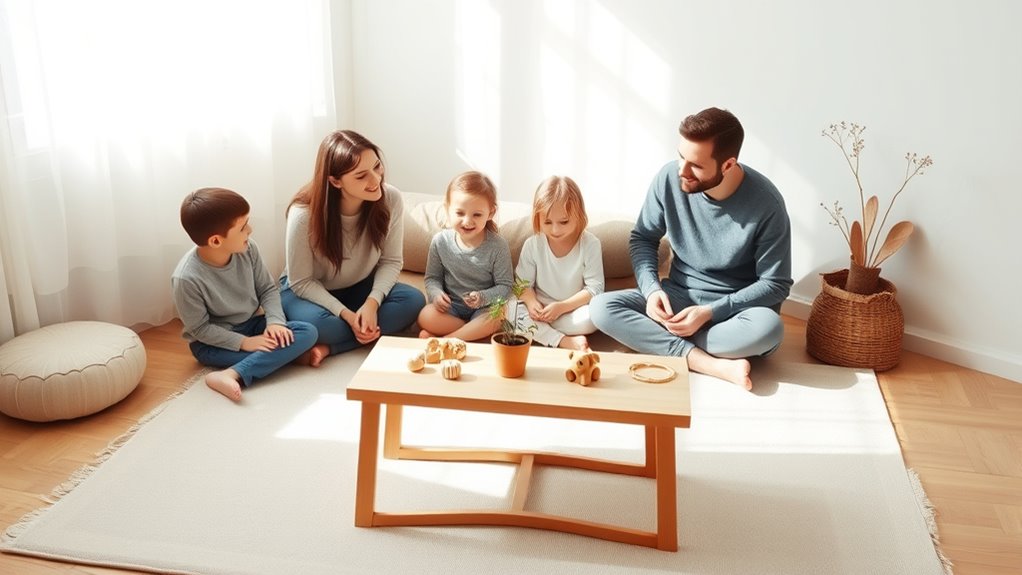Teaching your kids about enough through family minimalism involves modeling simple choices, emphasizing experiences over possessions, and setting clear boundaries around belongings. You can foster responsibility and gratitude by involving children in decluttering, encouraging responsible decision-making, and creating routines that promote connection over consumption. Celebrate small joys and teach mindfulness to cultivate inner contentment. Keep exploring how these principles can transform your family life into a calmer, happier environment filled with meaningful experiences.
Key Takeaways
- Model minimalist behaviors and prioritize experiences and relationships over possessions to teach kids about contentment.
- Set clear, age-appropriate boundaries on possessions and involve children in decluttering routines.
- Establish family rituals that promote togetherness, gratitude, and shared values beyond material goods.
- Encourage responsible decision-making and sharing by limiting possessions and teaching value awareness.
- Foster gratitude, mindfulness, and appreciation for simple joys to cultivate inner contentment and a sense of enough.
The Foundations of Teaching Kids About Enough
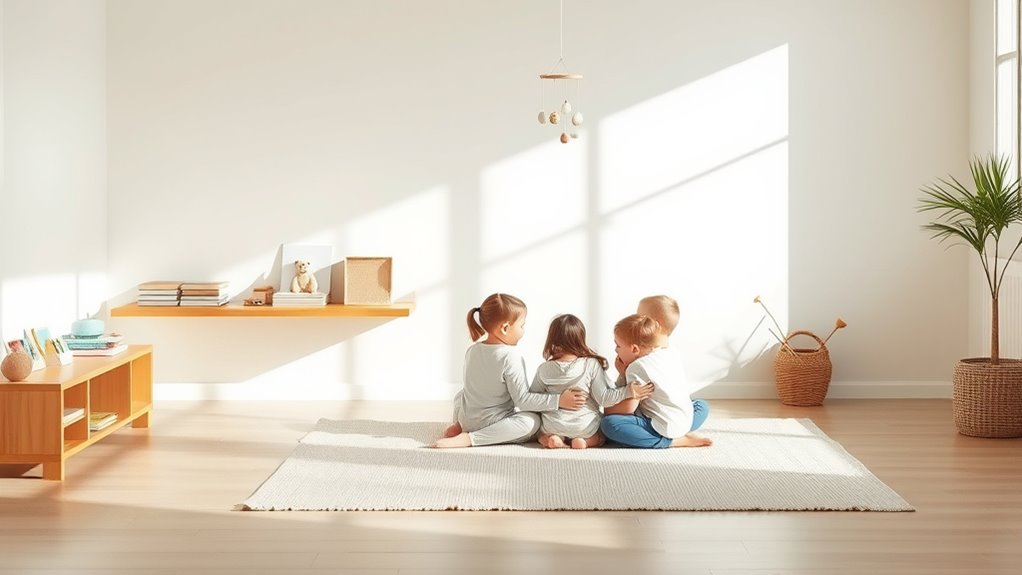
Teaching kids about enough begins with modeling a minimalist mindset yourself. Children learn best through observation, so demonstrate simplicity in your choices and behaviors. Keep your belongings organized and avoid impulsive shopping, showing that contentment comes from appreciating what you have. Talk openly about the value of experiences over possessions, emphasizing quality time and relationships. Set clear boundaries around possessions and avoid giving excessive gifts or clutter. Show gratitude for the essentials and prioritize mindful consumption. When children see you living intentionally, they pick up on these values naturally. Consistency is key—your actions will shape their understanding of what “enough” truly means. By embodying minimalism, you create a foundation that helps kids develop a healthy perspective on possessions and fulfillment. Incorporating simple and practical tools like portable camping gear can further reinforce the importance of valuing experiences over material items.
Developing a Mindful Approach to Possessions

Focusing on quality over quantity helps you create a more intentional home and reduces clutter. Encourage your family to make mindful choices when acquiring possessions, so each item serves a purpose or brings genuine happiness. By emphasizing thoughtful selection, you’ll foster a calmer environment and stronger appreciation for what truly matters. Incorporating minimalist principles into daily life can further support your efforts to maintain a clutter-free and meaningful living space.
Emphasize Quality Over Quantity
Developing a mindful approach to possessions means prioritizing quality over quantity in everything your family owns. Instead of buying many cheap items, focus on selecting durable, well-made products that last longer. This shift helps your family appreciate what you have and reduces the impulse to constantly acquire more. When you choose quality, your children learn to value craftsmanship and longevity, fostering gratitude and patience. Investing in fewer, better items also means less clutter and waste, making your home more organized and calming. Plus, high-quality possessions often perform better and require fewer repairs or replacements. By emphasizing quality, you teach your kids to make thoughtful choices and develop a deeper connection to their belongings, promoting contentment and reducing materialism.
Encourage Mindful Choices
Encouraging mindful choices starts with helping your family pause before making purchases or bringing new items into the home. When you create a habit of thoughtful reflection, your family learns to value what they truly need. To support this, consider guiding your kids to ask themselves:
- Do I really need this item now?
- Will this bring lasting happiness or just temporary excitement?
- How many similar items do I already have?
Fostering awareness of consumer trends helps children understand the influence of marketing and social media on their preferences. Encouraging this mindset helps children develop better decision-making skills and reduces impulsive buying. It also fosters gratitude for possessions they already have. By modeling patience and intentionality, you teach your kids to prioritize quality over quantity, ultimately cultivating a more mindful approach to possessions that benefits your entire family’s well-being.
Setting Age-Appropriate Expectations and Limits
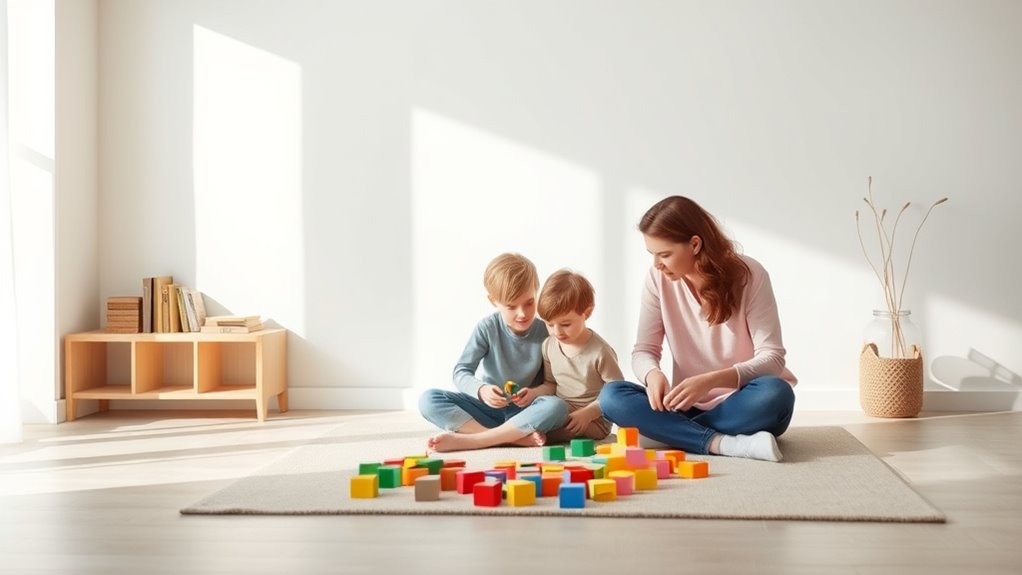
Setting age-appropriate expectations and limits is essential for helping children understand boundaries without feeling overwhelmed. You want to tailor rules to their developmental level, ensuring they’re clear and achievable. For young kids, keep limits simple, like “one toy at a time,” and explain why these boundaries matter. As children grow, gradually introduce more responsibility, such as managing chores or setting time limits on screens. Consistency is key; set routines that reinforce expectations and provide a sense of security. When boundaries are fair and predictable, children learn self-control and develop trust. Remember to communicate openly, listen to their concerns, and adjust limits as needed. Incorporating appropriate tools and strategies can further support your efforts, creating a structured environment that nurtures independence while maintaining a calm, organized environment that supports your family’s minimalism goals.
Encouraging Gratitude and Appreciation
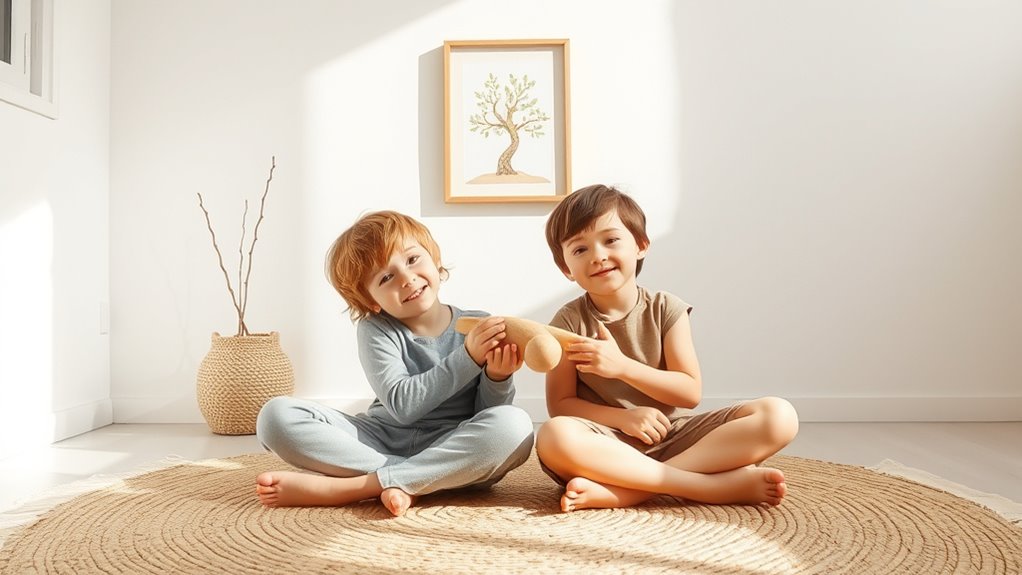
Fostering gratitude and appreciation in your family creates a positive atmosphere that reinforces minimalism’s benefits. When your kids learn to value what they have, they become less focused on acquiring more. You can encourage gratitude by sharing daily highlights, expressing thanks for small acts, or creating gratitude jars. This helps children recognize the abundance in their lives rather than longing for more possessions.
Additionally, modeling retail hours and mindful shopping habits can teach children the importance of intentional consumption.
To reinforce this mindset, consider:
- Celebrating simple pleasures like family meals or outdoor play
- Praising efforts and kindness instead of material achievements
- Encouraging reflection on what they’re thankful for each day
These practices cultivate contentment, reduce material cravings, and strengthen family bonds—all essential for embracing minimalism and teaching kids the true value of enough.
Involving Kids in Decluttering and Organizing
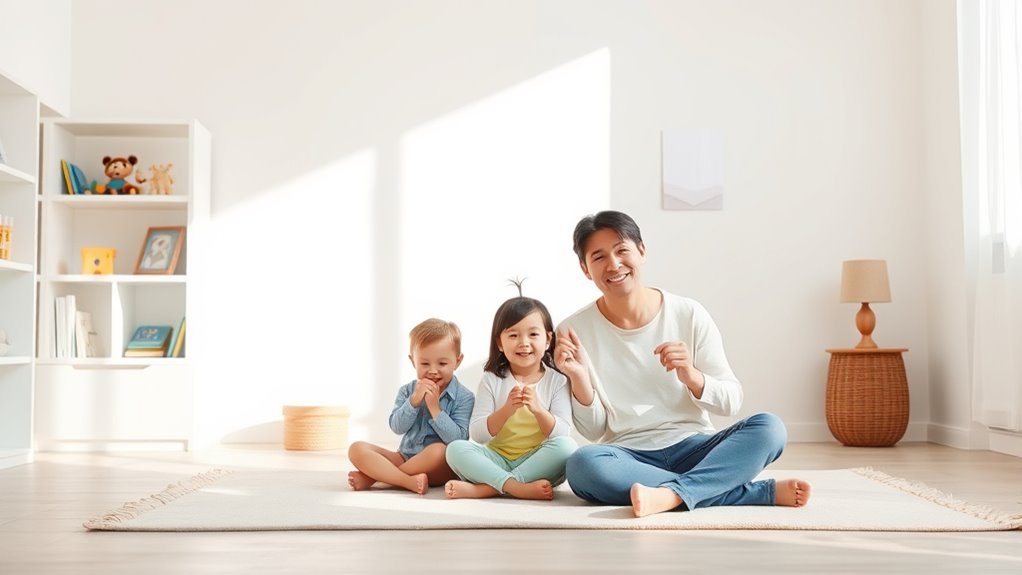
Getting kids involved in decluttering can be both fun and educational. You can turn sorting and organizing into games that teach responsibility while keeping the process engaging. By doing so, you help children develop valuable skills and foster a sense of ownership in maintaining a clutter-free home. Incorporating lessons about minimalism principles can further reinforce the importance of “enough” and help kids appreciate the value of simplicity.
Making Decluttering Fun
Have you ever wondered how to turn decluttering into a fun activity your kids actually enjoy? You can make it playful by turning tasks into games. For example, set a timer and see who can sort the most toys before it rings, or create a treasure hunt for items to donate or recycle. Using music or storytelling helps keep energy high and engagement strong. You might also:
- Create themed sorting stations, like “Toyland” or “Book Jungle”
- Offer small rewards or stickers for completing tasks
- Involve your kids in choosing where things should go, empowering their decision-making
- Incorporate positive reinforcement to motivate children and celebrate their efforts
These approaches shift decluttering from a chore into a shared adventure, making the process exciting and rewarding for everyone involved.
Teaching Responsibility Through Sorting
Turning decluttering into a teaching moment offers kids valuable opportunities to develop responsibility and organizational skills. Involve them in sorting belongings into categories—keep, donate, or discard. Ask questions like, “Is this item still useful or meaningful?” to encourage decision-making. Make it a game by timing how quickly they can sort their toys or clothes, fostering a sense of achievement. Let kids handle the process of packing donations or organizing their space, which builds ownership and accountability. Explain the importance of caring for possessions and respecting shared spaces. By guiding them through sorting, you teach responsibility, help them understand value, and establish habits for ongoing organization. Incorporating tuning modifications like suspension upgrades can serve as a metaphor for adjusting their habits to better fit their needs and environment. These skills benefit their independence and contribute to a calmer, more organized home environment.
Fostering Responsible Decision-Making and Sharing

By simplifying your home and routines through minimalism, you create an environment where children naturally learn responsible decision-making and sharing. When clutter is minimized, kids focus more on meaningful choices and understand the value of sharing. You can encourage responsible behavior by guiding them to decide what to keep and what to donate, fostering awareness of needs versus wants. Sharing becomes easier when possessions are limited, prompting children to think about others and develop empathy. Additionally, introducing eye patch benefits can serve as a metaphor for taking care of oneself and understanding personal boundaries. To support this, you can:
- Provide opportunities for kids to make choices about their belongings.
- Model sharing and responsible decision-making in daily interactions.
- Create situations where children practice giving and taking fairly.
This approach helps children develop self-control, respect for others, and a sense of responsibility, laying the foundation for healthy decision-making.
Creating Family Rituals That Emphasize Connection Over Consumption

As children learn to make responsible decisions and share thoughtfully, families can build on these skills by creating meaningful rituals that prioritize connection over material consumption. Focus on activities that foster togetherness, like weekly family dinners or outdoor walks. These rituals encourage genuine interaction, reducing the urge to buy or acquire things. Consistent routines build a sense of security and shared purpose. Use the table below to plan simple, intentional rituals that promote connection without relying on possessions:
| Ritual Idea | Focus |
|---|---|
| Weekly family dinners | Conversation and shared experiences |
| Nature outings | Appreciation of the environment |
| Game nights | Play and teamwork |
| Storytelling sessions | Creativity and bonding |
| Gratitude practices | Cultivating appreciation and mindfulness |
Additionally, incorporating family-centered activities like collaborative projects or volunteering can further strengthen bonds and teach kids the value of giving over getting.
Supporting Kids in Cultivating Inner Contentment

Supporting kids in cultivating inner contentment involves helping them find fulfillment from within rather than external possessions or achievements. You can do this by teaching them to appreciate simple joys, practice gratitude, and focus on meaningful experiences. Encourage mindfulness activities like deep breathing or quiet reflection to help them connect with their feelings. Creating a nurturing environment helps them develop resilience and self-awareness. Imagine your child:
- Smiling genuinely during a walk in nature, appreciating the moment
- Saying thank you for small acts of kindness, recognizing their own gratitude
- Engaging in creative play, expressing themselves without needing material rewards
These experiences foster a sense of sufficiency and peace that isn’t dependent on stuff. Supporting their inner growth builds a foundation for lasting happiness and well-being.
Frequently Asked Questions
How Can I Introduce Minimalism to My Young Children Effectively?
You can introduce minimalism to your young children by involving them in decluttering together, making it a fun activity. Explain simply that fewer toys mean more space for play and creativity. Encourage sharing and responsible organization of possessions. Set clear limits on new items and model mindful consumption yourself. Celebrate their efforts, emphasizing the joy of quality time and meaningful experiences over material stuff.
What Are Some Age-Specific Challenges in Teaching Kids About Enough?
Imagine telling a knight in shining armor that he already has enough. Teaching kids about enough faces age-specific challenges: toddlers might cling to objects out of comfort, while tweens could resist limits to independence. Younger children may struggle with patience, and older ones might compare possessions. You need patience, clear boundaries, and age-appropriate explanations to help them understand that happiness isn’t tied to having more.
How Do I Handle Sibling Conflicts Over Possessions During Decluttering?
When handling sibling conflicts over possessions during decluttering, you step in calmly and set clear boundaries. Encourage kids to share their feelings and listen actively. Use fair rules, like taking turns or dividing items equally, and remind them of the benefits of minimalism, such as more space and less stress. Reinforce cooperation and teamwork, turning conflicts into opportunities to teach sharing, negotiation, and respect for each other’s needs.
What Strategies Promote Long-Term Mindful Habits in Children?
You can promote long-term mindful habits in children by modeling consistency and patience, showing them how to prioritize what truly matters. Encourage regular reflection on their possessions and feelings, helping them recognize when they have enough. Use engaging activities like gratitude journaling or mindful moments to reinforce these habits. While toys and distractions tempt, remind them that simplicity fosters peace, focus, and genuine happiness, creating lasting mindful behaviors.
How Can I Balance Minimalism With My Child’s Emotional Attachment to Belongings?
You can balance minimalism with your child’s emotional attachments by involving them in decluttering decisions, respecting their feelings, and explaining the reasons behind it. Encourage them to choose which belongings are special and create a memory box for keepsakes. Practice patience and reassurance, emphasizing that possessions don’t define their worth. This approach fosters emotional security while teaching them about the value of quality over quantity.
Conclusion
By embracing minimalism as a family, you turn clutter into clarity and possessions into meaning. Remember, it’s not about what you own but the memories you create together. As you teach your kids about enough, you’re planting seeds of gratitude, responsibility, and contentment. Let this journey be a gentle reminder that true wealth lies in connection and simplicity—where less truly becomes more.
